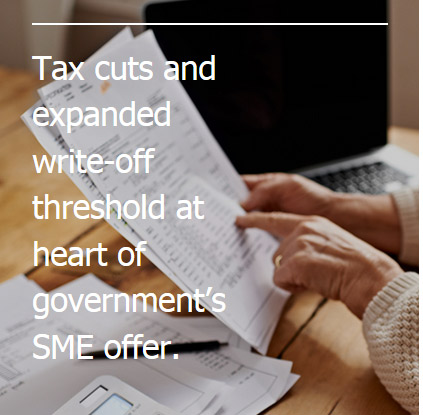
Tax cuts and expanded write-off theshold at heart of government SME offer
What the Coalition’s legacy policy settings and campaign promises have in store for the nation’s small business sector in its new government term.
With the dust from the federal election settled, Australia’s two million-plus small-to-medium-sized enterprises (SMEs) are assessing what the result means for them.
At least with the return of the Coalition, Australia’s SMEs are not dealing with a new government: they have the benefit of some policy continuity, with much of the policy package that the government took to the 2016 election aimed at building on what it had in place.
Eventually, Coalition policy calls for the company tax rate to be lowered progressively to 25% for all companies by 2026-27.
Company tax cuts to be extended
Last year, the government proposed to cut the company tax rate for small businesses – those with turnover of less than $2 million – from 30% to 28.5% from the 2015-16 financial year onward. Prior to the election, the Coalition promised to cut this rate further to 27.5% and lift the turnover threshold for eligibility to $10 million, which would hugely increase the number of firms paying the small business tax rate.
Eventually, Coalition policy calls for the company tax rate to be lowered progressively to 25% for all companies by 2026-27.
More businesses to qualify for instant asset depreciation
Currently businesses with annual turnover less than $2 million can, until June 2017, instantly write-off (that is, depreciate fully) assets under $20,000. The Coalition also took to the election a promise to extend access to that instant write-off to businesses with a turnover of less than $10 million – again, widening eligibility to many more businesses.
Unincorporated businesses encouraged to switch
Another major change affecting small business, which came in with the 2015 Budget, was the ability of sole traders and partnerships to incorporate – that is, change their legal structure to a proprietary limited company – without attracting a capital gains tax (CGT) charge for transferring “active” assets (those used in carrying out the business) into a new entity. This took effect on 1 July 2016.
If legislated, the company tax cuts and extension of access to the instant write-off would be “clear positives” for the SME sector and would encourage investment, Dr Greg Chapman
If legislated, the company tax cuts and extension of access to the instant write-off would be “clear positives” for the SME sector and would encourage investment, says SME adviser Dr Greg Chapman, chief executive of Empower Business Solutions. “Whenever you see reduced company tax, the company has more money to invest and the investments they make will have a higher return for them. On top of that, lifting the instant asset write-off threshold to $10 million is a very good deal in terms of encouraging investment and productivity improvement.”
In SMEs where turnover is below $2 million, Chapman says the “assets don’t tend to be very large,” but in the $2 million–$10 million turnover range they can start to become very meaningful. “You might be talking about a manufacturing business that needs another production line,” he says. “Even though only $20,000 of the capital cost qualifies, it can still be the difference in deciding to expand.”
Chapman says the government will get more bang for its buck by extending the turnover threshold to $10 million. “You find that people operating under $2 million turnover are often still getting the basics in place and making sure the phone keeps ringing, whereas people in that $2 million–$10 million range are more experienced and more switched on to increasing their business’ rate of return on investment. I think you’re going to get a greater response from people in that range than from below it,” says Chapman.
If your business comes under the proposed new $10 million turnover threshold, your accountant or adviser should be able to help you identify how you could benefit from the instant asset write-off rules.
The CGT relief for unincorporated businesses when incorporating is also important, he says. “As your business grows, it’s better that it be incorporated; some people who started off small, but didn’t incorporate, now have successful businesses but are trapped in an unincorporated structure. So CGT relief on that is a positive thing.
“It supports growing businesses, because if you’re unincorporated, you’re more at risk as your business grows – your personal assets are at risk, and that can be very limiting on a business’ growth” he says.
It is not yet clear whether the new, more generous but as yet unlegislated $10 million turnover threshold for other small business concessions will also apply to this rollover relief.
If your business is unincorporated, it might be worth talking to your accountant or business adviser about whether incorporating would suit you. If your business comes under the proposed new $10 million turnover threshold, your accountant or adviser should be able to help you identify how you could benefit from the instant asset write-off rules.




